Safety valve in the heating system: types, purpose, diagrams and installation
Due to improper operation, temperature changes and pressure spikes in the operation of autonomous heating systems, malfunctions can occur. The negative consequences in such situations are critical: starting with the breakdown of individual components, ending with the destruction of buildings and a serious threat to life.
The safety valve in the heating system will help to eliminate dangerous risks. What is he like and what is his principle of action? We will consider these issues in our article. We will also analyze the varieties of such valves and indicate the main differences between them, consider the rules of installation in the heating system and provide recommendations on the selection and adjustment of safety valves.
The content of the article:
What is a safety valve for?
Heating systems are filled with water, the temperature of which is approximately 15 degrees. Circulating in a closed circuit, the heat carrier heats up, significantly increasing in volume. At this time, the pressure exerted on the inner surface of the pipes and the devices installed in the system increases significantly.
Exceeding the permissible norm, in most cases more than 3.5 bar, results in:
- leakage in the joints of the pipeline parts;
- damage or rupture of connecting elements and pipes made of polymers;
- explosion of the boiler tank;
- short circuit of electrical equipment in the boiler room.
Solid-fuel boilers, in which it is difficult to regulate the heat transfer power, are the highest risk of emergency situations.
The performance of electric and gas equipment is quickly adjusted from starting to maximum performance and vice versa. Often present in them security automationshutting down work elements at excessive temperature rises.
The intensity of burning wood, coal and other types of fuel in a solid fuel boiler is adjusted by opening / closing the shutter. In this case, the heat transfer force does not change immediately, but gradually. Due to the inertia of the heat generator, the liquid coolant can overheat.

When the firewood in the chamber warms up well, bringing the water in the network to the required temperature levels, the air is blocked and the active flame begins to die out.
However, in a hot state, the furnace continues to generate accumulated heat. Reaching 90-95 degrees, the coolant boils and starts the inevitable intense vaporization. As a result, a sharp jump in pressure is provoked.
It is in these circumstances that a safety valve is activated. When the boundary pressure parameter is reached, it opens the shutter, freeing the way out for the formed vapor. After stabilization of the values, the valve closes automatically and switches back to sleep mode.
Its installation is required not only for solid fuel, but also for steam boilers, as well as furnaces equipped with a water circuit. Many modifications of heating equipment are completed with these devices at the production stage. Often this valve is one of the elements security groups. Typically, the device is inserted directly into the heat exchanger or installed in a pipeline near the boiler.
Varieties of devices and principle of operation
The design of the bleed valve includes two mandatory components: a locking part, consisting of a seat and a shutter, and a force action adjuster. There are several types of equipment that have their own characteristics. They are classified according to certain criteria.
Classification # 1 - by the clamp mechanism
In heating systems of private houses, apartments and industrial installations of low power, the spring type of the product is preferred.

The device has a simple and reliable structure, compact dimensions, the ability to combine with other elements of the security unit at an affordable price. The compression force of the spring mechanism depends on the pressure parameter at which the valve is activated. The adjustment range is affected by the springiness of the spring itself.
The principle of operation of spring fuses is as follows:
- the flow of water affects the shutter of the device;
- coolant movement is limited by spring force;
- critical pressure exceeds the compression force, lifting the spool rod up;
- fluid is sent to the outlet;
- the internal volume of water is stabilized;
- the spring closes the shutter, returning it to its original position.
The case of the springy device is made of high-quality high-strength brass using technologies and methods of hot stamping. Steel is used in the production of the spring. The membrane, seals and handle are made of polymers.
Some brands produce equipment that already has factory settings. Also in the range there are models that are customizable at the installation site during commissioning.

Lever-load fuses are not so widespread. In private autonomous systems with a boiler, they are rarely mounted.Operation is concentrated in the industrial sector in large industries where the diameter of the pipelines is at least 200 mm.
The force on the rod in such mechanisms is not given by a spring, but by a load hung on a lever. It moves along the length of the lever, adjusting the force with which the rod will be pressed against the saddle.
The lever-cargo valve opens when the pressure of the medium from the lower part of the spool exceeds the indicators coming from the lever. After that, the water leaves through a special outlet.

The response pressure, as well as the setting range, is determined by the length of the lever and the mass of the load. Lever fuses are not inferior to spring devices in terms of reliability, but they are more expensive. Devices are installed on flanged pipe fittings with a nominal diameter of 50 or more.
Classification # 2 - by shutter lift
In low-lift safety valves, the valve rises no higher than 0.05 in the diameter of the seat. The opening mechanism in such equipment is proportional.
It is characterized by low bandwidth and the most primitive design. Low lifting equipment is used on vessels with a liquid medium.

Full-height appliances have a higher shutter speed. This means that their throughput is much better than the previous version, so they are able to discharge larger volumes of excess coolant.
Classification # 3 - by speed
The valve cover of the proportional safety valves opens gradually. As a rule, the magnitude of the opening is proportional to the increase in pressure exerted on the inner surface. Simultaneously with the rise of the mechanism, the volumes of discharged coolant gradually increase.
The design of the devices does not limit the possibility of their use in a compressible medium, but nevertheless they prevail in systems with water and other liquids.

The peculiarity of the on-off valves is the instantaneous operation with full opening after reaching the boundary marks of pressure in the system, at which the fuse lock opens.
Experts recommend operating these devices in compressible environments. Among their main disadvantages include the presence of characteristic self-oscillations of the shutter.
When installing a two-position valve in a heating system with a liquid coolant, it should be borne in mind that during a sharp opening of the shutter a large amount of water will be discharged.
Because of this, the pressure drops too quickly. The valve closes instantly, which entails water hammer. Proportional devices do not cause such risks.
Features of three-way emergency valves
We should also talk about a device not so well-known to consumers - a three-way valve with a manual or electric switch. It is used in heating systems with low temperature circuits.
The design of the fuses is equipped with three holes, one of which is input, two are output. The flow of the medium is controlled by a damper made in the form of a ball or rod. Moving fluid is redistributed by rotations.

Imagine the situation: the house has a heating circuit with a system of conventional radiators and a warm floor. Technical requirements for the functioning of the second option provide for not too high coolant temperatures.
The boiler heats the water at the same temperature for all systems. In such conditions, there is a need for a redistributing device, the tasks of which the three-way valve perfectly copes with.
He is responsible for the following functions:
- delimitation of areas;
- distribution of flux density by zones;
- facilitating mixing of the heat carrier from the main supply / return branches for sending colder water to the warm floor pipeline than to radiators.
In order not to exercise constant control of the temperature of the medium on your own, you need to pay attention to the valve models equipped with a servo drive.
This device is powered by a sensor installed in a low temperature circuit. When the temperature marks change, a locking mechanism is triggered, which opens or closes the liquid supply from the return.
In more detail about the varieties of a three-way valve for heating and the criteria for its selection, we talked in the next article.
Tips for choosing the best model
Before settling on a specific safety equipment, it is necessary to familiarize yourself in detail with the technical characteristics of the boiler installation.

Do not neglect the study of the manufacturer's instructions, which indicate all the limit values.
A decisive role in choosing a device for heating have several criteria:
- Boiler performance.
- The maximum allowable pressure of the medium for the thermal power of the heating equipment.
- Diameter of the safety valve.
It should be checked that the pressure regulator in the device has a range within which the parameters of this or that boiler enter. The response pressure should be 25-30% more than the operating indicator required for stable operation of the system.

The diameter of the safety valve cannot be less than the connector of the inlet pipe. Otherwise, constant hydraulic resistance will not allow the fuse to fully perform immediate tasks.
The optimal material for manufacturing equipment is brass. It has a low coefficient of thermal expansion, which eliminates the destruction of the housing from the effects of strong pressure.
The control unit is made of heat-resistant plastic materials that retain the desired rigidity even when in contact with boiling liquid.
Installation and setup rules
Having planned the independent installation of a safety valve for heating, you should prepare a set of tools in advance. The work can not do without adjustable wrenches and wrenches, a Phillips screwdriver, pliers, tape measure, silicone sealant.
Before you begin, you need to determine the right place for installation. The safety valve is recommended to be mounted on the supply pipe not far from the outlet pipe of the boiler. The optimal distance between the elements is 200-300 mm.

In the regulatory documentation that comes with each device, the installation process is usually scheduled step by step.
Some key installation rules are unchanged for all types of valves:
- if the fuse is not mounted as part of a safety group, a manometer is placed next to it;
- in spring valves, the axis of the spring should have a strictly vertical position and be located under the body of the device;
- in the lever-cargo equipment, the lever is placed horizontally;
- in the pipeline section between the heating equipment and the fuse, installation is not allowed check valves, cranes, gate valves, circulation pump;
- to prevent damage to the housing during rotation of the valve, you need to be selected with a key on the side where the screwing is carried out;
- a drain pipe that removes the coolant to the sewer network or return pipe is connected to the outlet of the valve;
- the outlet pipe is not led directly to the sewer, but with the inclusion of a funnel or pit;
- in systems where fluid circulation occurs through natural pattern, the safety valve is at its highest point.
The nominal diameter of the device is selected on the basis of methods developed and approved by Gostekhnadzor. In resolving this issue, it is wiser to seek help from professionals.
If this is not possible, you can try using specialized online programs for calculation.

Valve adjustment is influenced by the type of clamp structure. In the spring fixtures there is a cap. Pre-compression of the spring is adjusted by rotating it. The accuracy of these products is high: +/- 0.2 atm.
In linkage devices, adjustments are made by mass gain or load movement.
After 7-8 operations in the installed emergency device, the spring and the plate wear out, as a result of which the tightness can be broken. In this case, it is advisable to replace the valve with a new one.
Conclusions and useful video on the topic
How the safety valve is made and what it consists of:
Safety valve as part of a safety group:
More on choosing and installing the optimum safety valve:
The safety valve is a simple and reliable equipment that will protect the housing from unforeseen emergency situations that occur in heating systems. To do this, it is enough to choose a high-quality device with suitable parameters, and then perform its competent setup and installation.
Choosing the right safety valve option for your heating system? Maybe you still have questions, the answers to which you did not find in the above material? Ask them to our experts by leaving a comment under the article.
Or maybe you want to supplement the material with interesting facts and useful recommendations? Or share the experience of installing the valve yourself in the system? Write your opinion about the need for such a protective device, share tips for choice, based on personal experience.

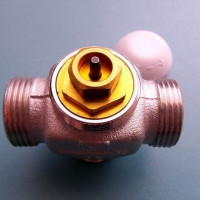 Three-way valve on the heating system: operation, selection rules, diagram and installation
Three-way valve on the heating system: operation, selection rules, diagram and installation 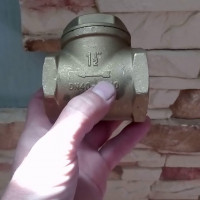 Check valve for heating: action, types, pros and cons + installation diagram
Check valve for heating: action, types, pros and cons + installation diagram  Expansion tank for open heating: device, purpose, main types + tips for calculating the tank
Expansion tank for open heating: device, purpose, main types + tips for calculating the tank 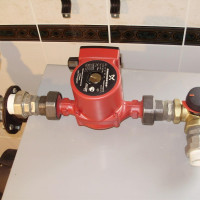 Installation of a circulation pump: types, purpose and features of its installation
Installation of a circulation pump: types, purpose and features of its installation 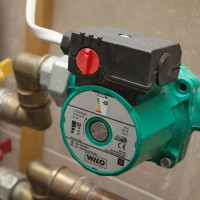 Connection diagrams of the heating pump: installation options and step-by-step instruction
Connection diagrams of the heating pump: installation options and step-by-step instruction 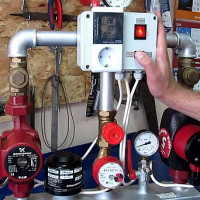 Water pump for heating: types, specifications and selection rules
Water pump for heating: types, specifications and selection rules  How much does it cost to connect gas to a private house: the price of organizing gas supply
How much does it cost to connect gas to a private house: the price of organizing gas supply  The best washing machines with dryer: model rating and customer tips
The best washing machines with dryer: model rating and customer tips  What is the color temperature of light and the nuances of choosing the temperature of the lamps to suit your needs
What is the color temperature of light and the nuances of choosing the temperature of the lamps to suit your needs  Replacement of a geyser in an apartment: replacement paperwork + basic norms and requirements
Replacement of a geyser in an apartment: replacement paperwork + basic norms and requirements
He installed heating from an electric boiler in his house. When assembling the system, it is indeed important to pay attention to the safety valve. I have a small area of the heated room, the slope is set according to the standard, so the pressure in the system was set to 1.8 bar. Nevertheless, he did not neglect the safety of u and installed a valve. When the pressure rises to 2.1 bar, it automatically releases air. I didn’t put it anymore, because the Chinese radiators do not know how they will behave. At least I'm sure that there will be no breakthrough in the system from overpressure.
The topic is useful for fans of the self-installation of certain devices and structures. For example, when buying a water heater in most cases, the safety valve is not included in the package. A person makes an independent installation and connection, unknowingly does not add a valve. In any heater, the guaranteed protection against overheating may not work, as a result, without overpressure, overheating or water hammer will occur, then you do not even need to predict the result.